Beta phase: March 1989 through August/September 1991
Major enhancements:
- Added: "Up-arrow" zoom gadget.
- Added: Backdrop window with support for basic patterns.
- Added: Digital clock in the Workbench title bar.
- Changed: Disk icons moved to the left-hand side of the screen.
- Changed: The Preferences icon used an Amiga 2000 image instead of an Amiga 1000 (early releases of 1.4).
- Changed: Window scroll-bar arrow gadgets were now grouped together in the bottom right-hand corner.
- Removed: 'Fuel gauge' from disk/volume windows.
Internal releases included (as much info as I have!):
- 1.4 Alpha 15A 36.1 (March 1989)
- Kickstart 1.4 Alpha 15 (36.15)
- Workbench 1.4 Alpha 15A (36.1)
- Extras 1.4 (36.8) B1
- Support 1.4A15 (36.1)
- 1.4 Alpha 15 version 36.5 (May 1989)
- (missing disks)
- 1.4 Alpha 16 (1989)
- Kickstart 1.4 (36.36)
- Workbench 1.4 Alpha 16 (36.3)
- AutoDocs-Includes 1.4 Alpha 16
- Support 1.4a16 Alpha 16
- 1.4 Alpha 18/Beta 1 (December 15, 1989)
- Workbench 1.4 Alpha 18 (36.8)
- Kickstart 1.4 Alpha 18 (36.022)
- Extras 1.4 (?)
- Autodocs-Includes 1.4 Alpha 18
- Kickit and the $200000 Kickstart image
- 1.4 Beta Exp. 36.1228? (1989)
- (missing disks)
- 1.4 Release B3 version 36.10 WB internal 36.1385 (pyramid zoom gadget)
- (missing disks)
- 1.4 Beta 4 (March 5, 1990)
- (missing disks)
- As of at least 36.1524, Workbench was finally given "2.0" status with the "2.0x" look and feel via its windows and most of its gadgets. Further refinements were made in 36.1720.
Example diskette(s):
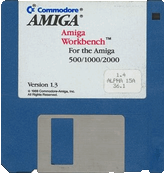
Screenshot:
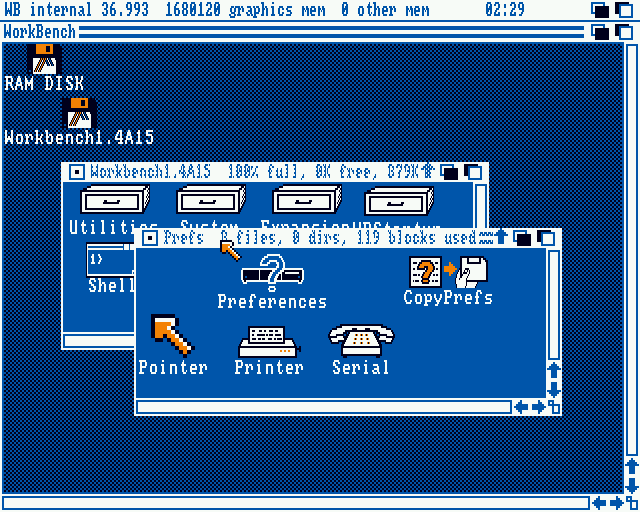
| Alpha Kick. | Beta Kick. | Boot Menu | Startup 1 | IconEdit 36.18 |
|---|---|---|---|---|
 |
 |
 |
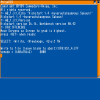 |
Startup 2 | Workbench 1 | Workbench 2 | Workbench 3 | WBPattern 36.7 |
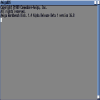 |
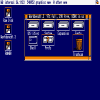 |
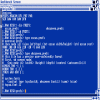 |
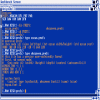 |
 |
Workbench 4 | Workbench 5 | Workbench 6 | Workbench 7 | WBScreen 36.57 |
 |
 |
 |
 |
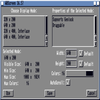 |
Workbench 8 | 36.1574 (note cycle gadget) |
Workbench 9 | Workbench 10 | Psuedo icon |
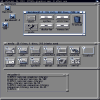 |
 |
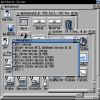 |
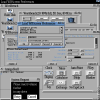 |
|
Startup 1 is courtesy of Janne Siren and the Finnish Amiga Users Group. It is of a 1.4 ROM-equipped Amiga 3000 after it was booted from a floppy "installed" on an Amiga 1200; hence the "Workbench 40.42" text. Note the unique "shaded" window gadgets. The very early Boot Menu (diagnostic section) from Alpha 15, for some reason was never introduced until Kickstart 3.0. In Workbench 7, the early (selected) 3D window scroll bars returned in the "New Look" scroll bars in Workbench 3.0+. | ||||
| Descriptions and Part Numbers | ||
|---|---|---|
| Various (OFS) DS/DD diskettes | ||
| Kickstart 1.4 Alpha 15 Exec 36.18 Kick 36.15 PN: 317951-01 | Workbench 1.4 Alpha 15A 36.1 | Extras 1.4 36.8 B1 |
| Support 1.4A15 36.1 | ||
- LocalH of amiga.org notes: "The reason you got two different Kickstart revisions is because you were actually running two different Kickstarts. Early A3000's used a hardware 1.4 ROM to boot to the OS selection menu which then would softkick either 1.3 or 2.0. When you booted with the SuperKickstart, you were running the Kickstart on that disk, obviously, whereas when you got the 1.4 bootup screen you were actually running the hardware 1.4 ROM."
- 1.4b1 came with four disks:
- Kickit and the $200000 Kickstart image
- Workbench
- Extras
- Autodocs+Includes
- Commodore was still officially referring to Workbench 1.4 at least as late as February 9, 1990 at the third European Amiga Developers Conference. Topics in the binder included:
- "1.4 At a Glance, Andy Finkel"
- "Workbench 1.4, David Berezowski
- "Programmers Guide to 1.4 Kickstart, Questions and Answers, Bart Whitebook"
- "AMIGA DOS 1.4, Randell Jesup"
- "1.4 Preferences, Eric Cotton"
- "Writing 1.4 Compatible Software Today, Andy Finkel and Bryce Nesbitt"
- "AMIGA DOS 1.4 Application Support Library, Randell Jesup"
- "Exec 1.4, Bryce Nesbitt"
- "Intuition V1.4: Documentation Update, Jim Macraz"
- Radio gadgets were originally round (visible in IconEdit 36.18) before being given a "squashed" look in later betas, and finally, in 2.04.
- Robert Miranda notes that: "V36 was the working base for the 680x0 A3000 (V36 was then used only as a SuperKickstart boot module for the A3000D). V35 never left Commodore walls, it seems—a curiosity, that."
- Kickstart 1.4 is actually a special version of Kickstart which loads the real Kickstart from a file called DEVS:Kickstart. Kickstart V2.04 was available as a ROM, or as a disk-based version for use with Amiga 3000s which had Kickstart v1.4. Amiga 3000s fitted with Kickstart v1.4 cannot use 68040 or 68060 processors, regardless of what version of Kickstart is eventually booted, because it relies heavily on the integrated MMU in the 68030 which varies to some degree from the MMU in 68040 and 68060 processors. Unlike most Amiga models, the A3000 supports both ROM-based Kickstarts and disk-based Kickstarts; although not simultaneously.
- An anonymous Amiga user shares some very interesting developer comments of Workbench 1.4 (Alpha 15)—see Workbench screenshots 7-11.
- Peter Cherna (former AmigaOS team member) explains the background and changes of Workbench Beta 1.4 through Workbench Beta 2.04.
- Richard Wagenfuehrer sent an image of a Workbench 1.4 Alpha 15A 36.1 disk. This disk was distributed at the Amiga San Francisco developer conference on June 7, 1989 (SF-Devcon 89.2). This release came with various autodocs, includes, etc. on three disks:
- Workbench 1.4 Alpha 15A 36.1
- Extras 1.4 36.8 B1
- Kickstart 1.4 Alpha 15 exec 36.18 (Kick 36.15), PN: 317951-01
- Newsbytes News Network published the first official news of Workbench 1.4:
AMIGA New Amiga OS Tested
WEST CHESTER, PENNSYLVANIA, U.S.A., 1989 JUL 28
Alpha test versions of Workbench v1.4, the operating system for the Commodore Amiga, have begun shipping in the U.S. As with all alpha-test versions, specifications are subject to change, but the new Amiga operating system has been dramatically redesigned to allow true multitasking, as well as the ability to view all filetypes, not just those with .info suffixes. Also included is virtual memory support, a feature often seen on the Apple Macintosh. Thus, if you attempt to run a package that needs more memory than is on your Amiga, Workbench v1.4 will start saving the unused areas of memory to disk. When the areas of memory are required again, Workbench v1.4 saves the current memory segments, loading the old memory back in. Other features of v1.4 of the Amiga operating system include extended font support, including scalable, outline, and colour fonts. Don't hold your breath on Workbench v1.4, however, as sources close to Commodore UK suggest that a production shipment of Workbench is not due for another six months.
- 2nd Amiga Developers Conference Frankfurt (January 1989) notes:
Amiga OS Version 1.4
Although it is early to make promises, here is an outline of the items expected to be in version 1.4:
- Support for the enhanced custom chips.
- Support for monochrome hires monitor A2024.
- Character-mapped console device.
- Bitmap scaling.
- Intuition gadget system changes.
- Commodities Exchange.
- Preference changes.
- Workbench changes.
- Serial.device and parallel.device.
- AmigaDOS:
- FastFileSystem as standard.
- Standard file requester.
- Expanded library of DOS calls.
- Record locking.
- Enhanced Shell.
- Improved script language.
- Improved commands.
- ColorFont support.
- Faster text in ROM.
- Overscan support.
- More math library enhancements, including single-precision IEEE.
- And, of course, many bugs fixed.
- The second published review of Workbench 1.4 was the August 1989 issue of Amazing Computing, entitled "V1.4: A Pre-preview" [pages: 1 2 3 — courtesy of archive.org]
- In September, another review of Workbench 1.4 was written by ORLANDO of Brainstorm.
- An informal preview (Amiga user and date unknown) is also available.
- Holger Kruse posted on comp.sys.amiga.misc on September 11, 1999: "... V36 only contained an extremely incomplete implementation of dos.library. Lots of calls were added for V37, so programs need to be able to distinguish between both to avoid crashes."
- Matthew Garrett notes "If there was a missing font/device/library, instead of just failing, a requester would pop up with several options: Retry, Check Drive, Check All Drives, or Cancel. The 'Check All Drives' was the fun one, since it then scanned the fonts/devs/libs directory on every other drive to see if it could find the file—very handy on a floppy based system when you didn't have room for diskfont.library v37 or something. Other than that, the main interesting features were green recoverable alerts rather than amber ones, as well as a 2.0-style bootmenu that managed to be different to the one in 2.01 and 2.04."
- Jeff Grimmett explains how to see Workbench 1.4 with a soft-kicked Amiga 3000:
- Shutdown the Amiga.
- Hold down both mouse buttons when you power on.
- You will get a Kickstart 1.3 / 2.0 Kickstart Menu. Select neither!
- Instead, move your cursor to where the window's close gadget should be (upper left) and click it.
- You might have to fumble around, but eventually the computer will react and boot into 1.4. You will, of course, get error messages as the OS 2.x partitions will be used for startup, and they require newer Kickstarts, but you'll see some rather interesting GUI concepts. :-)
- Christian Stich notes that the use of a ROM tower in the Amiga 3000 was independent of the ROM used (1.4, 2.04, or 3.1). He adds that his Amiga 3000 Rev. 8.9 (for all intents and purposes equal to a Rev. 9.3) came with the 1.4 boot ROMs, but now has 3.1 ROMs as he installed a 68040. The ROM tower was used on early Amiga 3000 motherboards to change from a ROM layout to an EPROM layout (there might have been very few ROMs with ROM layout, but most of the ROMs—including his 1.4 ROMs—used the EPROM layout).
- Amiga 3000 1.4 ROM Alpha 5 (Part Numbers: (photo 1 | photo 2) 390629-02 ROM0V5 ©1990 (32-bit Low Word, ROM 0 Alpha V5), 390630-02 ROM1V5 ©1990 (32-bit High Word, ROM 1 Alpha V5).
- Brian of amiga.org notes that "I have a Kickstart.rom file rev 36.022 from an A3000 which is an "Alpha 18" version."